In the last 2 decades, I worked with enterprises as a consultant and tech vendor to deploy advanced analytics & AI solutions. I looked into more than 50 legal tech companies using generative AI and categorized the leading products.
Click the category names below to see leading players in that category:
| Legal AI software | Category | |
|---|---|---|
1. |  Cecilia AI by Disco Cecilia AI by Disco |
|
2. |  CoCounsel by Thomson Reuters CoCounsel by Thomson Reuters |
|
3. |  Smith AI Smith AI |
|
4. |  ndMax by NetDocuments ndMax by NetDocuments |
|
5. |  EverLaw EverLaw |
|
Explore more details on top legal AI assistant tools that can boost productivity and efficiency of legal professionals:
| Tools | Tool type | Pricing | # of employees |
|---|---|---|---|
| Cecilia AI by Disco | Platform | Not shared publicly | 1,024 |
| Clio Duo | Platform | - Start: $39/month - Essentials: $79/month - Advanced: $109/month - Complete: $139/month | 1422 |
| Harvey AI | Platform | Not shared publicly | 147 |
| Lexis AI by LexisNexis | Platform | - Legal search: $99 - Drafting: $250 - Document upload & review: $12 - Document upload & summarization: $250 | 10,200 |
| Practical Law AI by Thomson Reuters | Platform | - Drafting & negotiating: $302.25/month - Litigation & advisory: $302.25/month - Premium plan: $367.90/month | 33,102 |
| Blue J L&E | Legal Research Assistant | Not shared publicly | 45 |
| Casetext's CoCounsel by Thomson Reuters | Legal Research Assistant | - Basic subscription: $110 per month - Full access: $400 per month | 71 |
| Darrow AI | Legal Research Assistant | Not shared publicly | 181 |
| Vincent AI by vLex | Legal Research Assistant | Not shared publicly | 268 |
| Law ChatGPT | Contract Drafter | - Free plan - Associate plan: $49.00 - GC: $79.00 - GC Plus: $149.00 | 84 |
| ndMax by NetDocuments | Contract Drafter | Not shared publicly | 425 |
| PLAI Assistant by PocketLaw | Contract Drafter | - Go: €990/year - Pro: €9900/year - Enterprise: Upon request | 52 |
| Spellbook | Contract Drafter | Not shared publicly | 67 |
| DoNotPay | Legal AI Chatbot | Subscription plan: $36 every three months. | 20 |
| Juro | Legal AI Chatbot | Not shared publicly | 107 |
| Smith AI | Legal AI Chatbot | - Starter: $285/month - Basic: $765/month - Pro: $1950/month - Enterprise: Upon request | 280 |
| EverLaw | Contract Reviewer | Not shared publicly | 469 |
| LawGeex | Contract Reviewer | - Individual businesses: $399/month - Startups: $799/month - Established businesses: $1599/month - Large scale law firms: $2799/month. | 30 |
| LegalMation | Contract Reviewer | Not shared publicly | 41 |
| Kira Systems by Litera | Contract Reviewer | Not shared publicly | 42 |
*The table lists top legal AI tools in alphabetical order, grouped by their respective categories.
Compare shortlisted legal AI software
Legal AI software, also known as AI legal assistants, uses GenAI legal technology to automate repetitive tasks, freeing professionals to focus on more complex legal issues.
Despite the potential benefits, the adoption of legal AI tools within the legal industry has been slow due to a lack of understanding by 51% of professionals and limited time by 49%.1 Here is a market landscape for legal AI tools:
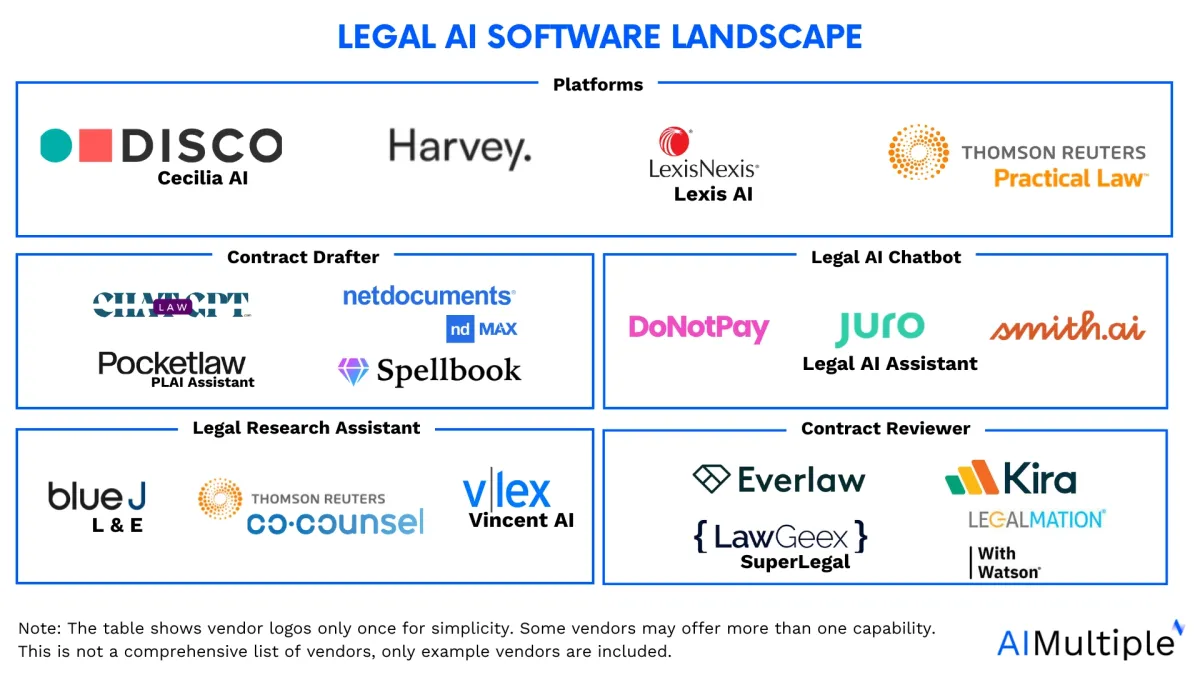
Top legal AI platforms: Features & Pricing
Some of these tools deliver all core features, we name these as legal AI platforms. Major tools listed in the alphabetical order include:
1.) Cecilia AI by Disco
Cecilia AI by Disco is an AI-powered platform designed to expedite legal investigations and streamline workflows through features, such as:
- Cecilia timelines to upload case documents and receive AI-generated summaries.
- Cecilia Q&A to interact with evidence by asking questions about the case and receiving answers supported by cited documents from the law firm’s database.
- Cecilia auto review to automate document review using generative AI by allowing for simplified tag descriptions in plain English and receiving tagged documents with narrative justifications for each decision.
- Cecilia deposition summaries to summarize depositions with citations, topics, and dates, facilitating easy understanding of testimony and navigation to key points.
Pricing
DISCO offers five distinct pricing plans based on the capabilities companies require, with pricing available upon request for each plan.
Here is a video to understand the interactive Q&A capability of Cecilia:
2.) Clio Duo
Clio Duo is an AI assistant integrated into Clio Manage, designed to enhance legal practice management. It automates tasks such as data retrieval, bill generation, and client communications, operating securely within Clio’s environment. Clio Duo features include
- Document summarization: Condenses lengthy legal documents into concise summaries.
- Client communication assistance: Drafts professional emails and text messages for client interactions.
- Smart recommendations: Prioritizes tasks and suggests actions to optimize workflow.
- Audit log functionality: Maintains a record of AI activities for transparency and compliance.
3.) Harvey AI
Harvey AI is a domain-specific foundation model developed on OpenAI’s GPT and leverages broad legal data to enhance its functionality. The platform can integrate with workflows and existing systems, like content management system to help lawyers in tasks such as contract review and regulatory compliance by:
- Reviewing contents which enables lawyers to conduct in-depth analysis of legal documents and compare different contracts or regulations side by side.
- Improving clauses which suggests improvements to clauses within legal documents based on best practices, industry standards, and specific client needs, aiding in strengthening contracts and agreements.
- Providing answers to legal queries which can create responses to legal questions posed by lawyers, leveraging its extensive database and knowledge of legal principles to provide accurate and relevant information.
- Summarizing documentation which summarizes lengthy legal documents or case files, condensing complex information into concise summaries that are easier for lawyers to review and understand, thereby saving time and effort in the research process.
- Analyzing other documents forms like video, and audio content to deliver real-time insights and feedback, enhancing the efficiency of legal analysis and decision-making processes.
- Implementing advanced analytics such as Natural Language Processing (NLP), object recognition, sentiment analysis, and speech-to-text conversion to analyze extensive datasets and other legal documents, providing valuable insights and suggestions to legal professionals.
- Creating customizable dashboards with metrics to track content engagement levels, providing a comprehensive overview of legal content performance.
In 2023, Harvey AI received an $80 million investment, bringing its total funding to over $100 million and valuing the company at $715 million. 2
Pricing
Harvey AI pricing can be obtained by contacting the sales team.
4.) Lexis AI by LexisNexis
Lexis AI, developed by LexisNexis, is a legal generative AI platform, offering features like:
- Conversational search to Interact with Lexis+ AI in a conversational manner, receiving quick and confident resolutions to legal research issues through a comprehensive case law collection, editorial analysis, and data visualization.
- Drafting to generate well-crafted arguments, contract clauses, and client communications using authoritative content based on practice notes, checklists, annotated forms, and AI drafting tools across 20+ practice areas, with guidance from over 1,750+ practitioners.
- Summarization to obtain legal summaries instantly, without the need to navigate through multiple search results.
- Document analysis to extract and summarize key insights from uploaded firm documents swiftly. Leverage deep AI legal analysis for both litigation and transactional documents, ensuring confidence in finalized legal documents.
- Additional features like AI-powered data-driven insights into judges and courts for litigation success, along with visibility into competition through comparison and experience analytics.
Pricing
Lexis+ AI charges $99 for legal search capability, $250 for GENAI drafting, $12 for Generative AI Document Upload & Review, and $250 for GENAI Document Upload & Summarization. Lexis+ AI provides a free trial option for users to explore its capabilities before making a commitment.
5.) Practical Law AI by Thomson Reuters
Practical Law combines generative AI with resources crafted and maintained by a team of 650 full-time attorney-editors. The platform allows users to:
- Ask practical Law AI an interactive search capability that can generate answers based on Practical Law’s comprehensive collection of how-to guides, templates, and checklists.
- Draft with standard documents and clauses to complete with drafting annotations, notes, and negotiation tips in the formal legal language.
- Access practice notes which are concise explanations of complex legal issues to facilitate quick understanding of new or existing legal matters.
- Customize checklists such as timelines, flowcharts, tables, decision trees, and issue lists, ensuring clarity on how to proceed in any legal scenario.
Pricing
Pricing plans change based on the client type being law firm, general counsels and government. For Law firms, there are three options:
- Access to only drafting and negotiating plan $302.25/month
- Access to only litigation and advisory costs $302.25/month
- Premium plan with access to both and other additional features covering $367.90/month.
Legal research assistant
Legal research can help lawyers build strong arguments by looking at hundreds of important decisions and finding similar cases based on key factors and outcomes. This feature can also allow in-house counsel to offer fair termination packages by learning from relevant case law, avoid expensive disputes by making unbiased reports, and decide whether to handle issues, handle matters internally or seek external counsel.
Some of the top tools in this category are listed in alphabetical order as:
5.) BLUEJ L&E
BlueJ L&E is a legal research platform and case management software that harnesses AI to support legal experts in accelerating their research and analysis processes, as attested within 65-72 weeks. The tool provides the following capabilities:
- Reduce time on research & analysis: Quickly pinpoint analogous decisions based on factors and outcomes, rather than relying solely on keywords.
- Avoid missing cases: Identify, organize, and access the most recent cases to ensure the delivery of the most informed outcomes.
- Scenario planning: Utilize your research findings to strategize, generate reports, and conduct interviews with potential clients.
Pricing
There is no pricing information disclosure on the product website.
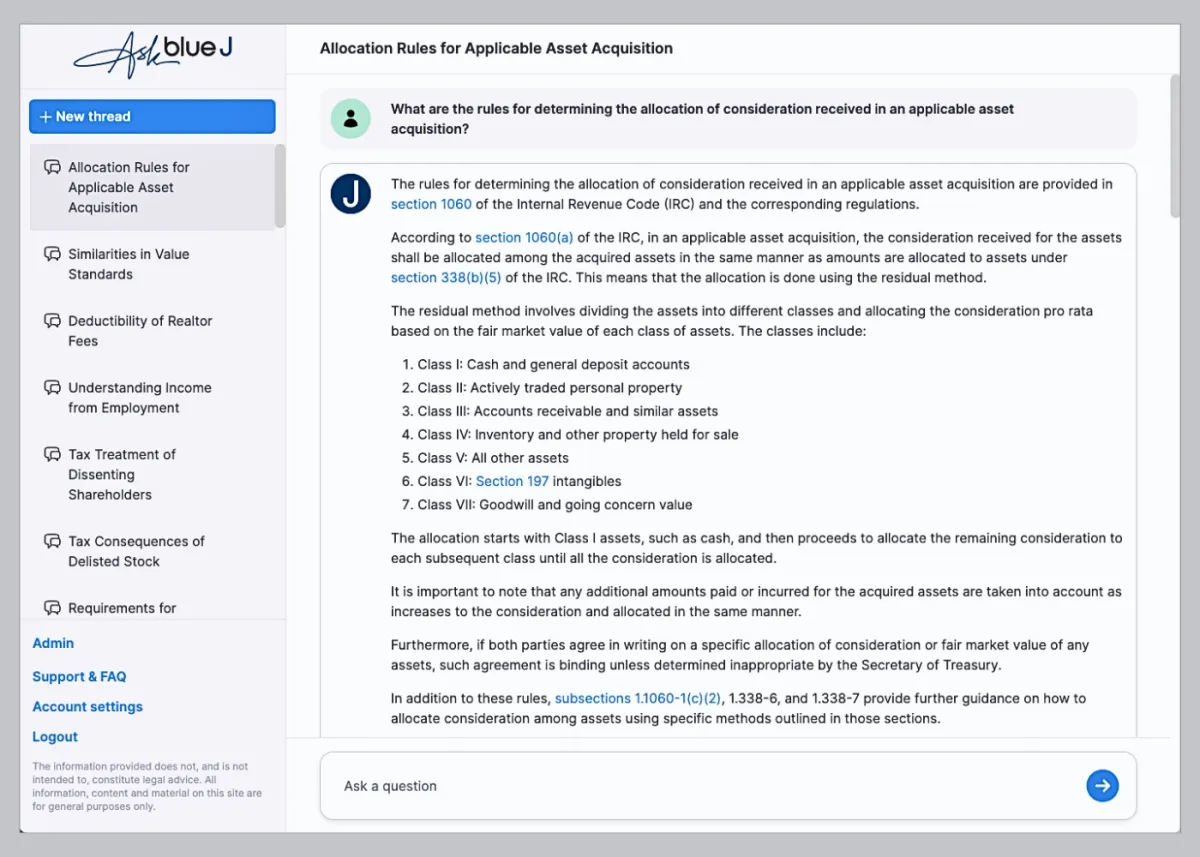
7.) Casetext’s CoCounsel
Following the acquisition of Casetext by Thomson Reuters, the firm introduces CoCounsel, an AI assistant developed in collaboration with OpenAI, utilizing the capabilities of GPT-4 specifically for the legal work. CoCounsel is designed to expedite legal research processes by understanding and reporting the findings equivalent to a postgraduate level.
Beyond legal research, CoCounsel can:
- Review documents
- Searches database for relevant legal information
- Assist lawyers to prepare for the trial
- Summarize research findings
- Deliver preliminary drafting of legal memoranda
- Verify contract data and compliance through document analysis
Pricing
The platform offers a basic subscription plan starting at $110 per month (on an annual basis), providing access to certain AI features for legal research. For full access to CoCounsel, a subscription of $400 per month is required, billed annually.
8.) Darrow AI
Darrow AI is a justice intelligence platform that uses AI to help legal professionals identify high-value cases by analyzing extensive datasets for potential legal violations. It connects lawyers with plaintiffs nationwide, streamlining case discovery and evaluation through features like:
- Case matching: Aligns cases with appropriate law firms based on expertise and jurisdiction.
- Data-driven intelligence reports: Provides insights into evidence, damages, and legal precedents.
- Financial case valuation predictions: Estimates the financial worth of cases using predictive analytics.
- Plaintiff discovery Across states: Connects lawyers with potential plaintiffs across all 50 U.S. states.
9.) Vincent AI by vLex
Vincent AI developed by vLex is an AI-powered research assistant that can help lawyers to anticipate opposing claims and automatically creating counter-argument by providing answers with full citations from vLex’s global database of legal information. Vincent AI offers the following features:
- Precedent map to visualize a case’s connections to other documents, aiding in determining its status as good law and facilitating easy navigation through related precedents.
- Key passages to access to the most cited sections of a judgment, along with insights into their application history for deeper understanding of legal concepts.
- Cited authorities to present information about the authorities cited within a case, streamlining the research process.
- In-force notifications to ascertain whether a case or act is currently in force or repealed, ensuring access to the most up-to-date legal information.
- Subsequently cited to identify how and where a judgment has been cited subsequently, with the option to navigate to the relevant case for further examination of applied passages.
vLex offers other large language models that can allow
- Drafting questionnaires and propose defenses, including arguments for each party.
- Document workflows to summarize documents, extract facts and build timelines to ensure compliance with policies.
- Comparisons of jurisdictions, laws across different states and countries to address client needs
- Litigation workflows to extract claims, key facts, and relief sought by finding and comparing similar litigation.
- Case analysis and search to extract legal issues, summarize headnotes, and find semantically-related documents to reduce the risk of missing information and determine case relevance swiftly.
Pricing
Users can schedule a demo to explore pricing options and start their free trial to experience Vincent AI firsthand.
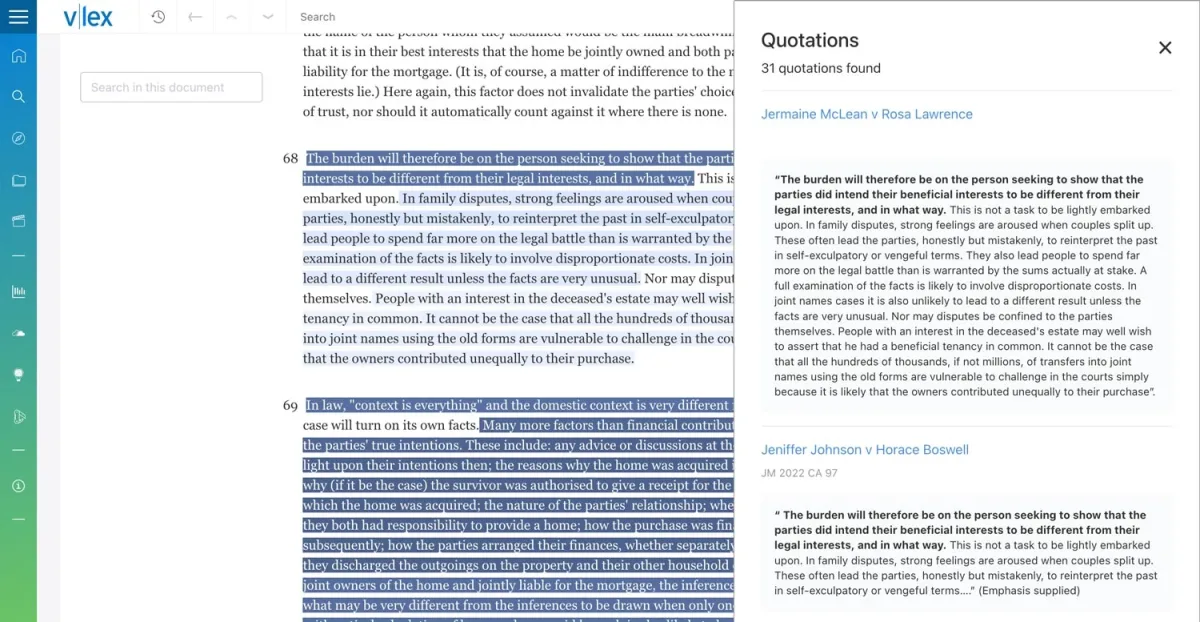
Contract drafter
By drafting legal documents with the help of artificial intelligence, legal teams can reduce the time and effort traditionally required for manual drafting processes while enhancing efficiency and accuracy. Top contract drafting tools are listed as:
10.) Law ChatGPT
Law Chat GPT utilizes OpenAI’s natural language processing (NLP) and machine learning algorithms, coupled with custom training, to streamline the online generation of legal documents. Employing a deep learning neural network architecture, it can generate a wide range of legal documents, including contracts, agreements, letters, and research materials.
Users can inquire, access pre-defined legal templates (e.g., breach notification or demand letters), instantly generate custom clauses, and retrieve relevant case information. Furthermore, Law Chat GPT assists in analyzing legal issues and supports legal research writing endeavors.
Pricing
Law ChatGPT offers monthly and yearly subscription plans. Monthly plans starts from $49.00 USD with varying word credits, such as Associate with 25,000 words and the Most Popular GC plan from $79.00 USD with 100,000 words credit.
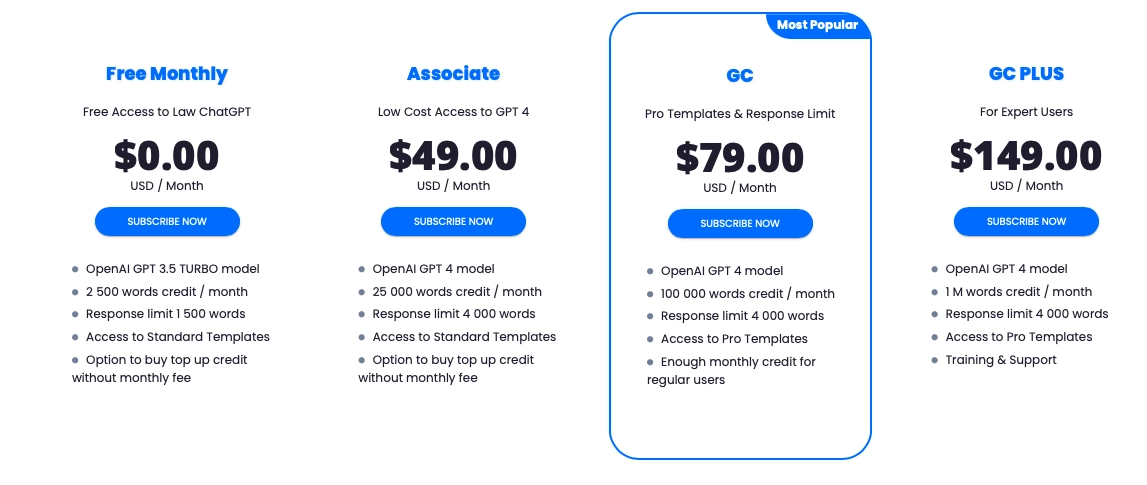
11.) ndMax by NetDocuments
ndMAX is an AI-powered suite integrated within the NetDocuments platform, specifically designed for the legal community. The firms can use the tool to:
- Generate formatted draft documents aligned with internal precedents and playbooks, ensuring consistency and adherence to branding standards.
- Extract information from documents and store it in a database for future reference and analysis.
- Review and compare contracts against firm-specific clauses and best practices to identify any discrepancies, ensuring contractual integrity.
- Summarize documents such as depositions and automatically categorize and save summaries to the appropriate workspace.
- Build customized scripts for questioning witnesses, facilitating preparation for depositions or trials.
- Ask plain-language questions on document-related inquiries with plain-language questions, enhancing drafting.
Pricing
The product website does not provide any pricing information.
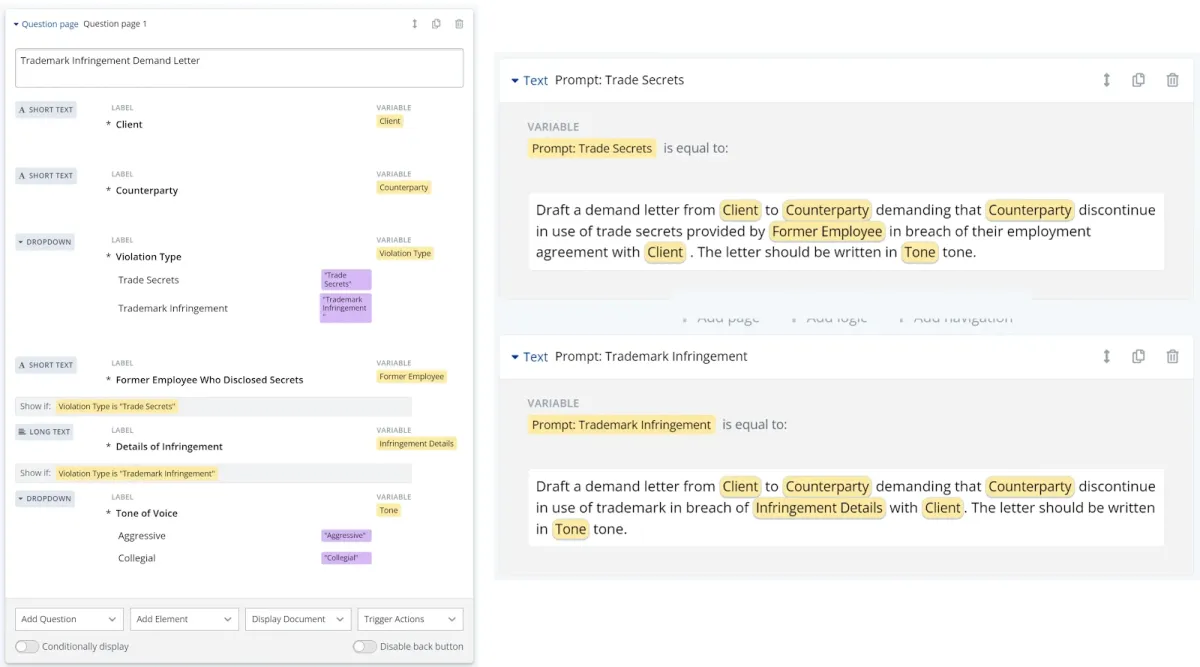
12. PLAI Assistant by PocketLaw
PLAI Assistant offers comprehensive support for drafting, reviewing, and understanding legal documents, including the creation of summaries. It leverages leverage LLMs to provide instant answers to questions and suggestions for streamlined drafting. Its features are:
- Drafting with recommendations on contract wording, addressing specific contract types, contexts, and business/legal requirements.
- Interactive document review through Natural Language Chat to uncover insights, risks, and clarifications within lengthy contracts, offering instant responses to document-related queries.
- Summarization to simplify contract reviews by distilling complex documents into concise summaries, highlighting important information and providing deep dives into selected sections or clauses.
Pricing
The pricing plans for the service range from €990/year for the GO plan with 1 base user, 1 admin user, and access to 50 templates to the PRO plan at €9,900/year for 10 base users, 2 admin users, and full template library for 1 jurisdiction, with an ENTERPRISE plan also available upon request for custom features and pricing.
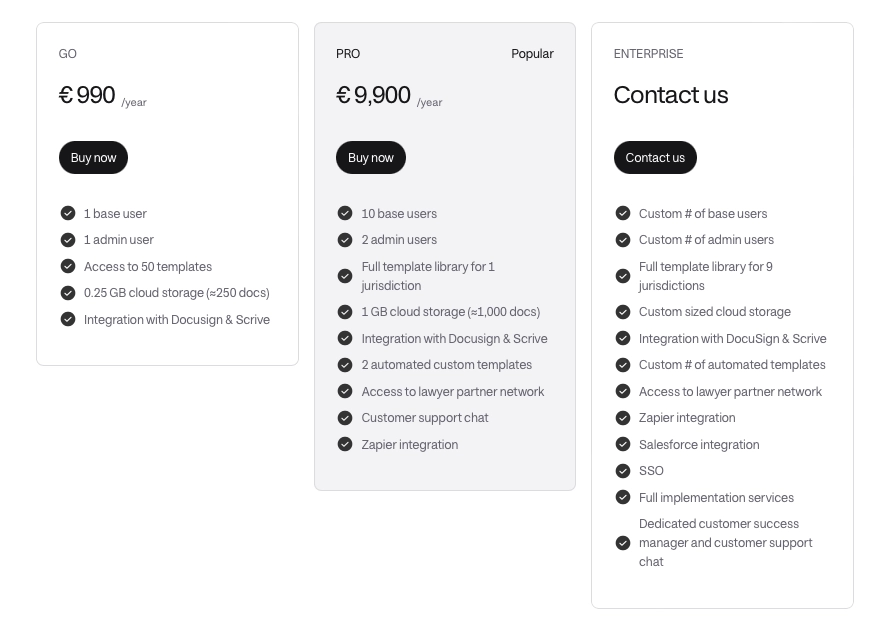
13. Spellbook Legal
Spellbook is an AI copilot employing generative AI to draft, review and manage contracts.Spellbook can review entire contracts and leave comments to help legal teams to approve and apply comments with ease.
- Risk identification: Automatically highlights risks and non-market terms within contracts.
- Redlining and suggestions: Suggests precise changes and comments based on the prompts.
- AI Capabilities: Leverages large language models (LLMs) and large multimodal models (LMMs) like OpenAI’s GPT-4.
Pricing
Spellbook does not share any pricing information on its website. However, the tool offers 7-days free trial.
Legal AI chatbots
Legal AI chatbots are conversational agents powered by artificial intelligence to interact with users, answer legal questions, provide legal guidance, and automate various legal tasks to improve client service, and streamline routine legal processes.
14. DoNotPay
DoNotPay is an AI-powered chatbot platform that assists users in various areas such as protecting privacy, finding hidden money (e.g. uncovered assets and refunds), and navigating bureaucratic processes.
Its features include assistance with both
- Legal issues like appealing parking tickets, disputing traffic tickets, and fighting bank fees
- Practical tasks like canceling subscriptions, finding unclaimed money, and scheduling appointments with government agencies.
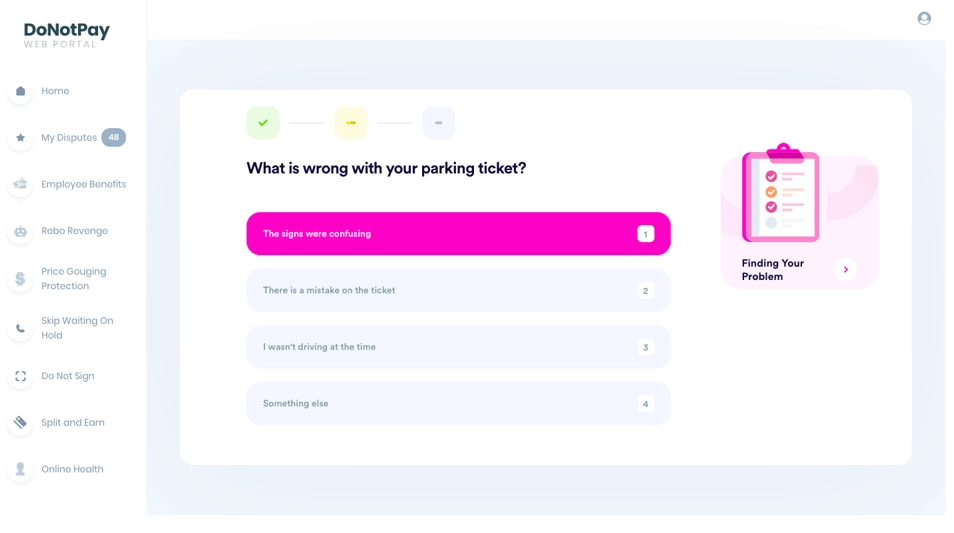
Pricing
DoNotPay offers a subscription plan priced at $36 every three months, granting access to its services via both the website and app.
15. Juro
Juro is a contract automation provider offering an interactive legal AI assistant that simplifies contract-related tasks. This legal chatbot offers:
- Drafting to create contracts and amendments in a refined legal language using automated templates.
- Reviewing contracts by scanning documents for risks and revising clauses based on established guardrails.
- Summarizing contracts and individual clauses for easy sharing with teams.
- Automated contract management by setting guardrails for routine contracts and automatic reminders for important dates and deadlines to automate processes, ensuring efficient self-service while maintaining oversight.
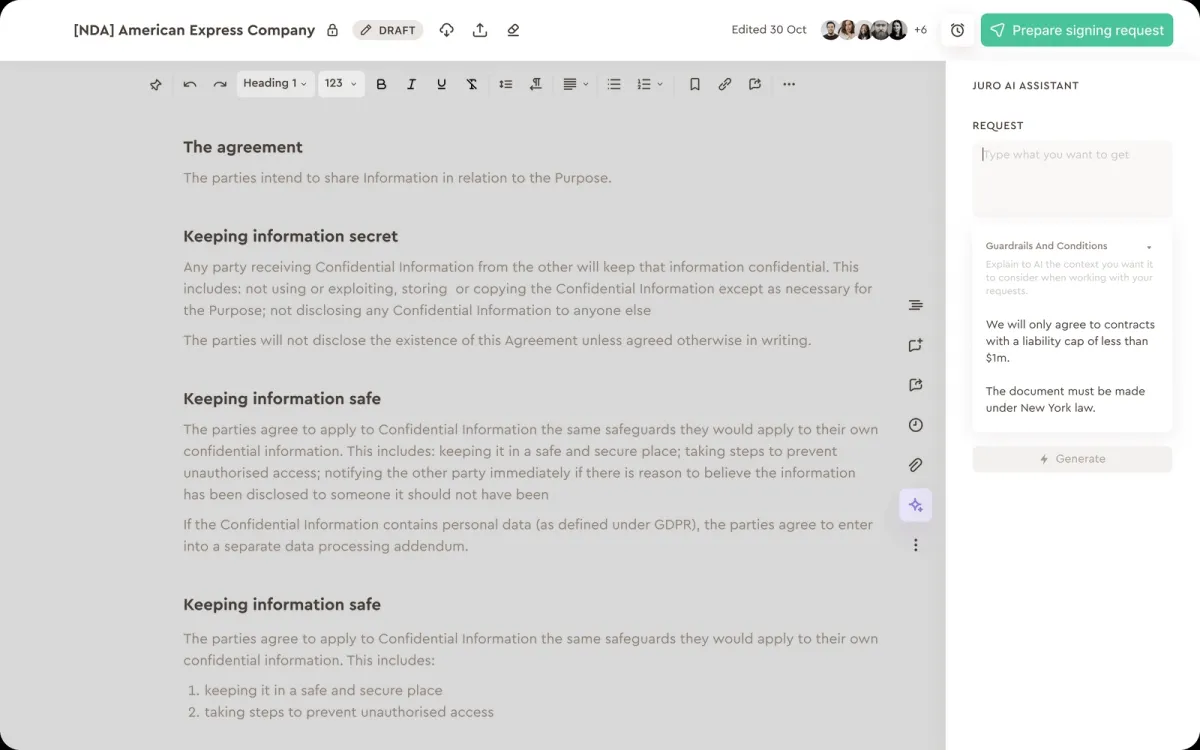
Pricing
Juro offers pricing plans tailored for startups, medium-sized, and large-scale companies, with varying access levels to features. Specific prices are available upon request.
16. Smith AI
Smith AI is a virtual receptionist that is designed for law firms to handle calls and texts 24/7, screen new leads, book consultations and collect payments. The chatbot leverages machine learning (ML) and natural language processing (NLP) to discern caller intents and route calls. This tool ensures that legal professionals can focus on billable work without missing out on potential clients or calls from existing clients. Smith AI provides:
- Real-time data visualization and call summaries
- Outreach calls and campaigns to speed up sales and support
- Live chat and text services to screen customers and website visitors.
Pricing
The tool offers four pricing tiers designed for different business sizes and needs, ranging from Starter at $285 per month for 30 calls, to Enterprise plans with customizable features and pricing adjusted based on high-volume needs.
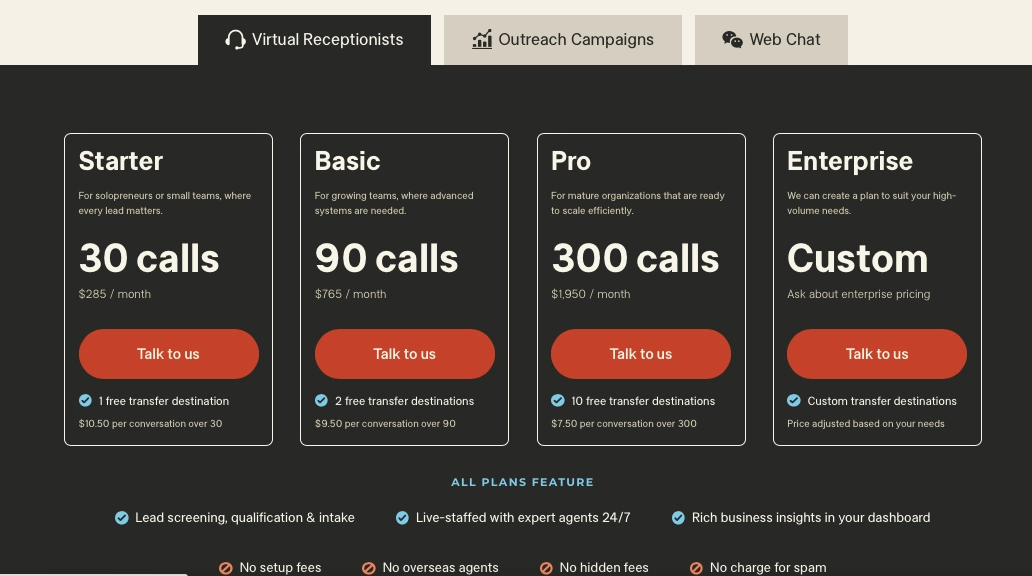
Contract reviewer
This category covers tools that primarily help any law firm with the contract analysis and legal document review process.
17. EverLaw
Everlaw is an e-discovery tool, offering AI assistant with key functionalities like:
- Summarizing findings and documents
- Adding citations for crucial evidence
- Providing responses to open-ended questions
Pricing
The company delivers more detailed pricing information through a sales demo.
18. Kira Systems
Kira Systems, acquired by Litera in 2021, leverages ML to extract and analyze contract content, featuring over 1,000 built-in smart fields for common clauses and data points. It offers features like:
- Quick study to create custom smart fields for unique needs.
- Workflow management for real-time editing and intuitive project management.
- Insights and reporting to summarize and export data efficiently.
Pricing
The company offers a sales demo to try the product and discuss the price.
19. LawGeex
Lawgeex is a contract automation software that can review and revise contracts based on your organization’s specific policies, guidelines, and legal frameworks.LawGeex promote a generative AI tool, SuperLegal allowing legal teams to
- Ensure consistency across contract documents
- Streamline the review process
- Expedite deal closures.
In the total economic impact study conducted by Forrester Consultingg 11 , LawGeex was helpful to:
- Reduce contract-review time by 75%, freeing up lawyers to handle more complex tasks. This saves over 6,500 hours in three years, with a present value of $449,859.
- Downsize onboarding and training expenses by 30% due to turnover and promotions. This results in a present value benefit of $18,886 over three years.
- Save time and effort required to create a playbook with a present value expense of $13,700 for the organization.
- Avoid the need to hire extra staff to handle simpler contracts by ensuring that lawyers dedicate only 25% of their time to these tasks.
Pricing
Superlegal presents four distinct pricing options designed to suit diverse business requirements:
- Individual Business Owners: $399 per month on an annual plan, including 2 contract reviews per month.
- Startups: $799 per month on an annual plan, with 6 contract reviews per month.
- Established Businesses: $1599 per month on an annual plan, offering 15 contract reviews per month.
- Large Scale Law Firms: $2799 per month on an annual plan, featuring 30 contract reviews per month.
20. LegalMation
LegalMation offers automation for litigation tasks and provides insights through four key capabilities:
- Complaint response creator that generates responsive documents for defense attorneys based on uploaded complaints or petitions, matching attorney-generated documents’ style and content.
- Discovery response creator that automates responding to written discovery requests, saving time for legal professionals with customizable options for efficiency and consistency.
- Legal analytics that provides insights into litigation data, including risk assessment, outcome predictions, counsel comparison, and upcoming diversity index.
- Matter profiling that automates summarizing complaints and petitions, offering structured reports to streamline workflows and reduce errors for law firms and corporate legal departments.
Since 2019, LegalMation has partnered with IBM WatsonX to integrate GenAI into its platform.
Pricing
The product website does not disclose any pricing plan information.
Major LLMs for legal AI applications
LLMs, like ChatGPT, Claude AI, Gemini, and Microsoft Copilot for Microsoft 365, have the potential to streamline legal workflows, improve efficiency, and assist with various legal tasks. Here is an overview of how these tools can be tailored for legal applications:
| LLMs | Latest model | Legal features | Pricing |
|---|---|---|---|
| ChatGPT | GPT-4.5 | - Legal drafting - Research assistance - Email & document communication | - Free: $0/month - Plus: $20/month - Plus: $25/month - Pro: $200/month - Enterprise: Custom |
| Claude AI | Claude 3.5 Sonnet | - Complex cognitive tasks - Contract & document analysis - Privacy for sensitive data | - Free: $0/month - Pro: $18/month - Team: $25/month - Enterprise: Custom |
| Gemini AI | Gemini 2.0 | - Real-time legal research - Cross-platform content interpretation (text, video, audio) | - Free tier: Up to 1,500 RPD - Paid tier: $35 per 1,000 requests (RPD) |
| Copilot by Microsoft 365 | GPT-4 | - Document management - Email summaries - Draft generation | - Plus: $30/month |
| Perplexity AI | Llama 3.1-Sonar Series | - Legal search - Case tracking | - Free plan: $0/month - Pro plan: $20/month |
| Meta | Llama 3.1 | - Open-source flexibility - multi-modal capabilities | - Free |
1.) ChatGPT
ChatGPT, developed by OpenAI, is an AI chatbot renowned for generating human-like text responses. ChatGPT can facilitate the legal sector by drafting legal motions, assisting in legal research, and aiding in the creation of legislative proposal.
Latest Model: GPT-4.5
Capabilities for legal applications:
- Legal drafting: ChatGPT can assist in drafting legal documents, such as contracts, agreements, and briefs. It can also help generate legal language that adheres to specific formats and jurisdictions.
- Research assistance: It can summarize legal texts, provide insights into case law, and even help draft memorandums by summarizing case precedents or statutes.
- Communication: Lawyers can use ChatGPT to draft professional emails, legal letters, or client communications.
Pricing
- Free Plan: $0/month
- Includes: Access to GPT-4o mini, real-time web search, limited access to file uploads, data analysis, image generation, and voice mode, use custom GPTs
- Plus Plan: $20/month
- Includes: all in free and also:
- Extended limits on messaging, file uploads, data analysis, and image generation, advanced voice mode with video/screensharing, access to deep research & multiple reasoning models, preview access to GPT-4.5, code edits with macOS desktop app, limited access to Sora video generation
- Includes: all in free and also:
- Pro Plan: $200/month
- Includes: all in plus and also:
- Unlimited access to all reasoning models & GPT-4o, unlimited advanced voice/video/screensharing, o1 Pro mode for higher compute power, extended access to deep research & Sora video generation, preview access to Operator.
- Includes: all in plus and also:
- Team Plan: $25/user/month (billed annually) or $30/user/month (billed monthly)
- Includes: all in plus and also:
- Higher message limits for GPT-4o, Custom GPTs for team, Secure & collaborative workspace with admin console & billing, Team data excluded from AI training by default
- Includes: all in plus and also:
- Enterprise Plan: Custom Pricing
- Everything in Team, plus:
- Higher message limits & expanded context window, Access to multiple reasoning models (including o1 Pro mode), Enterprise data encryption & compliance (SOC 2, GDPR, CCPA), SCIM, SSO, domain verification, user analytics, & GPT controls.
- Everything in Team, plus:
2.) Claude AI
Claude AI, developed by Anthropic, is an AI-powered chatbot introduced in 2023. It delivers detailed and contextually relevant responses to user queries, similar to ChatGPT. Claude AI can serve legal professionals by generating ethically sound content, aiding in legal research, and assisting in drafting documents, all while adhering to ethical guidelines.
Latest Model: Claude 3.5 Sonnet
Capabilities for legal applications:
- Complex cognitive tasks: Claude AI can be useful for analyzing legal texts, parsing through large amounts of documentation, and identifying key clauses or points in contracts and agreements.
- Confidentiality: Claude’s strong privacy features make it suitable for law firms dealing with sensitive client data, as it does not use user prompts or responses for training without explicit permission.
Pricing
- Free Plan: $0
- Includes: Access via web, iOS, and Android; image and document interaction; access to current Claude models.
- Pro Plan: $18/month (billed annually) or $20/month (billed monthly)
- Includes: All Free Plan features, plus document and chat organization with Projects; access to additional Claude models; Claude 3.7 Sonnet with extended thinking mode.
- Team Plan:$25/user/month (billed annually) or $30/user/month (billed monthly)
- Includes: All Pro Plan features, plus central billing and administration; early access to collaboration features; minimum of 5 members required.
- Enterprise Plan: Custom pricing (contact sales)
- Includes: All Team Plan features, plus expanded context window; single sign-on (SSO) and domain capture; role-based access with fine-grained permissions; SCIM (System for Cross-domain Identity Management); audit logs.
3.) Gemini (formerly Google Bard)
Google Gemini, previously known as Google Bard, is Google’s advanced multimodal AI model developed by Google DeepMind. Launched in December 2023, Gemini can enhance legal practices by assisting in drafting legal documents, conducting comprehensive research, and streamlining case preparation.
Latest Model: Gemini 2.0
Capabilities for legal applications:
- Real-time legal research: Gemini can pull real-time information from the web, making it particularly useful for lawyers who need to research up-to-date case law or legal precedents.
- Cross-platform integration: Gemini’s ability to interpret various forms of content, including text, video, and audio, can help lawyers review court hearings, depositions, or online legal seminars.
Pricing
- Google One AI Premium: $19.99 per month (student discount available).
- Includes: Access to Gemini Advanced AI model, 2TB Google One cloud storage, and integration with Google Workspace applications.
- Gemini for Google Workspace: Varies based on selected Google Workspace plan (Business Standard, Business Plus, Gemini Business, Gemini Enterprise).
- Includes: AI integration within Google Workspace applications (Gmail, Docs, Sheets, Slides, Meet). Specific features vary by plan.
- Gemini in Google Cloud (Vertex AI): Pay-as-you-go, based on usage (model, data volume: text, images, video).
- Includes: Access to Gemini models via Vertex AI for custom AI application development. Costs are based on input and output token usage.
4.) Copilot for Microsoft 365
Copilot, developed by Microsoft, is an AI assistant integrated into Microsoft 365 applications like Word and Excel. Copilot can assist legal professionals by generating content, automating tasks, and providing data insights within Microsoft tools.
Latest Model: GPT-4o
Capabilities for legal applications:
- Document management: Copilot can analyze trends within legal documents, summarize emails, and even generate drafts for legal correspondences such as client updates, status reports, or internal memos.
- Efficiency: By integrating directly into Microsoft Office apps like Word and Excel, Copilot can automate mundane tasks such as formatting, allowing legal professionals to focus on more complex aspects of their work.
- Compliance and security: Given the security features of Microsoft 365, Copilot provides an added layer of assurance, especially when working with sensitive legal data or communicating with clients.
Pricing
- Annual Plan: $30.00 per user/month (paid yearly)
- Monthly Plan: $31.50 per user/month (paid monthly, annual commitment)
- Included:
- Available in Word, Excel, PowerPoint, Outlook, and Teams, Copilot Chat & Copilot Pages for AI-powered collaboration, Copilot Studio to create AI agents and automate workflows, Copilot Dashboard for tracking adoption and impact, Enterprise-grade security, privacy, and compliance.
- Included:
5.) Perplexity AI
Perplexity AI is an AI-driven search engine that aggregates information from various online sources to provide concise answers to user queries. In the legal sector, it can assist professionals by swiftly compiling relevant case law, statutes, and legal commentary, thereby enhancing research efficiency.
Latest Model: Llama 3.1-Sonar Series
Capabilities for legal applications:
- Case tracking: It improves project management for legal teams by streamlining access to crucial case-related information.
- Legal search: Perplexity AI provides direct answers and citations to legal queries, by sourcing the latest case law, statutes, and legal precedents.
Pricing
- Free plan: $0/month with limited access to features.
- Pro plan: $20/month or $200/year
- Includes access to Llama 3.1-Sonar Series with model selection options (GPT-4o, Claude-3, Sonar Large, etc.), Enhanced AI-powered search and premium research tools, GDPR-compliant processing.
6.) Meta AI
Meta, formerly Facebook, has developed AI technologies such as the large language model LLAMA, aiming to enhance user experiences across its platforms.
Latest Model: Llama 3.1
Capabilities for legal applications:
- Open-source flexibility: Legal professionals can customize it for their specific needs, from contract analysis to document automation.
- Multimodal capabilities: Supports text, image, and structured data processing, making it useful for legal workflows requiring document analysis.
Pricing
- Free:
- GDPR-certified for data privacy compliance, Open-source, allowing legal teams to develop their own AI-powered legal applications.
Selection criteria
We select top legal AI tools based on the following criteria:
- Employee count: 20+ employees on LinkedIn.
- Use of generative AI: Tools that claim to leverage generative AI technology.
- Focus on the legal practices: Tools tailored solely for legal research, document generation, and review.
We acknowledge that there are large language models (LLMs) applicable to the legal sector, which falls outside of the scope of this research.
FAQ
What is Legal AI?
Legal AI refers to the use of advanced AI technologies like machine learning and natural language processing to enhance legal practice. Recently, legal AI tools have embraced generative AI models, which employ deep learning techniques to understand and replicate human-like language patterns, enabling the autonomous generation of complex legal texts.
Legal AI capabilities include:
1. Document drafting: Generate and review legal contracts quickly based on provided information, customizing contracts to meet specific client needs.
2. Data extraction: Instantly extract financial or transactional data from various legal sources for processing or reporting purposes.
3. Data analysis: Analyze and synthesize large volumes of general legal data to facilitate predictive analytics and decision-making support for legal teams.
4. Compliance monitoring: Monitor changes in laws and regulations, ensuring compliance by interpreting and understanding legal requirements.
5. Legal research and analysis: Automatically analyze relevant legal research topics and find necessary legal sources to address complex issues, streamlining research and ensuring accuracy.
6. Due diligence risk assessment: Identify abnormalities in legal documents to investigate further, eliminating the need for manual review and speeding up the process.
7. Contract management: Streamline the legal workflow with end-to-end functionality, enabling real-time collaboration, automated approval workflows, instant document querying, and deadline tracking.
What are the benefits of legal AI?
Law firms can benefit from legal AI tools to:
1. Streamline workflows: Legal AI tools streamline processes by automating repetitive tasks, allowing legal professionals to focus on more complex and strategic aspects of their work.
2. Improve efficiency: By analyzing vast amounts of data quickly and accurately, legal AI enhances efficiency within legal workflows, reducing the time and effort required to complete tasks.
3. Provide valuable insights: Legal AI provides valuable insights to legal professionals by synthesizing and interpreting complex data, enabling them to make better-informed decisions and strategize effectively.
4. Enable better-informed decisions: Legal AI enables lawyers to make better-informed decisions by providing them with comprehensive analysis and insights derived from data processing.
5. Deliver higher-quality legal services: Legal AI enhances the quality of legal services by optimizing processes, improving accuracy, and facilitating more thorough analysis, ultimately leading to better outcomes for clients.
What is AI governance?
AI governance practices aim to build and manage an AI inventory, mitigate AI bias and other generative AI risks, by adopting ethical AI tools, such as:
1. AI compliance solutions
2. AI governance tools
3. Responsible AI tools.
These tools can be helpful to deliver LLMs and other AI applications that are ethical and lawful. Such tools should not be confused with legal AI tools that delivers AI tools to help lawyers and law firms.
What is the best legal AI software?
The best legal AI software depends on your needs. Tools like document review, legal research, or contract analysis vary in effectiveness. Popular ones offer features like natural language processing for faster, accurate insights, automated workflows, and compliance checks.
Is there a legal AI bot?
Yes, legal AI bots exist. They use natural language processing to communicate in conversational language, providing services like answering legal questions, drafting documents, or guiding users through legal processes efficiently.
Is there an AI for law?
Yes, AI is widely used in law for contract review, legal research, case prediction, compliance, and more, improving accuracy and efficiency.
Disclaimer
AIMultiple acknowledges that our analysis may not encompass all large language models available. We strive to continually update and broaden our examination as the Legal AI market evolves.
We recognize that the tools we have discussed may offer multiple capabilities. However, for the sake of simplicity and reader convenience, we have categorized the tools under one umbrella, while noting their additional features.
Further reading
Discover more on legal tech such as generative AI legal and AI legal:
- Generative AI Legal Use Cases & Examples
- Top 20+ GRC Software Compared based on 4,000 Reviews
- Compare Top 20+ AI Governance Tools: A Vendor Benchmark
External resources
- 1. 50 must-know legal tech stats for 2024 | LexisNexis Blogs . LexisNexis
- 2. Harvey raises $80M Series B from Elad Gil, Kleiner Perkins, OpenAI and Sequoia. Harvey AI
- 3. “Ask Blue J enhances user experience through GPT-4 and conversational.” BlueJ Accessed at April 17, 2023
- 4. Home | Knowledge Base.
- 5. Legal AI & Workflow Automation | ndMAX by NetDocuments.
- 6. NetDocuments Lays Out Plans for Series of 'ndMAX' Generative AI Products and Releases the First, For Customizing Document Automation in PatternBuilder | LawSites.
- 7. Contract Management System & eSign Contract System Pricing | Pocketlaw.
- 8. The Easiest Way to Dispute Nashville Parking Tickets [4 Steps].
- 9. What is contract AI? A guide to AI contract tools in 2025.
- 10. Smith.ai Plans & Pricing for 24/7 Sales & Support.
- 11. “The Total Economic ImpactTM Of LawGeex” Forrester. May 2021. Accessed at April 17, 2024.

Comments
Your email address will not be published. All fields are required.